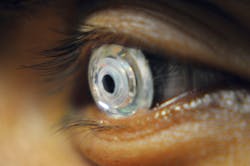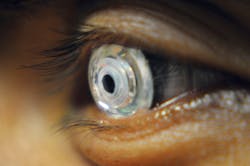OPHTHALMOLOGY/MICRO-OPTICS: Telescoping contact lens switches between magnified and normal vision
A telescoping contact lens able to switch between normal and magnified vision could someday improve vision for patients with age-related macular degeneration (AMD) and other eye diseases. The lens does a better job of collecting light than current implantable telescopes and, once the design is fine-tuned, it will be less invasive as well. It is also less bulky than current glasses-mountable telescopes.
The contact lens, developed by engineers at the University of California, San Diego and their partners, is 1 mm thick. The team used aluminum mirrors, fit tightly together, to create a ring-shaped telescope that they embedded in the lens. The center allows for normal, non-magnified vision; its periphery, where the telescope is located, magnifies 2.8 times.
The lens' optics allow switching between normal and magnified vision with the addition of modified, off-the-shelf 3D television glasses: Without the glasses, the contact lenses superimpose both normal and magnified images. With the glasses on, a liquid-crystal shutter will switch open a window for normal or telescopic vision. The crystals change the way light is refracted onto polarized films embedded in the contact lens so that only light with a certain orientation, or polarization, passes through the glasses to the contact lens, hitting either the telescopic portion of the lens or the area designed for normal vision. The engineers are working on a hands-free infrared LED switch that will allow the wearer to activate one of the two functions by either winking one eye or blinking with both eyes.
The researchers tested the lens on a life-size mechanical model of the eye that they built. The model was connected to an imaging system that allowed them to see on a computer screen what the mechanical eye saw. They also ran computer models to simulate the lens' performance. Tests performed with the mechanical eye showed that the lens' magnified image provides a much larger field of vision than other magnification approaches currently in use. The quality of the images was also good.
Ongoing research on the lenses is funded through a larger research program. Last summer, UC San Diego researchers worked with partners at Innovega and Paragon Vision Sciences to conduct human clinical trials on a preliminary version of the wearable lens. A second round of clinical trials will occur later this year. "While there is a great deal of work still ahead, we see a clear path to a comfortable low-vision aid powered by a contact lens, which will help a significant number people," said Professor Joseph Ford, who led the work.
Researchers built the prototype lens with polymethyl methacrylate (PMMA), a material commonly used in early rigid contact lenses, and they are now working on a new design that uses a gas-permeable material. The updated version will have polarizers integrated into the center or edge of the lens surface. In early lab tests the polarizers were attached externally, and a pair of 3D TV glasses was modified to do the switching.
"In the future, it will hopefully be possible to go after the core of the problem with effective treatments or retinal prosthetics," said Eric Tremblay, co-author on the paper and alumnus of Ford's research group, now at the École Polytechnique Fédérale de Lausanne (EPFL) in Switzerland. "The ideal is really for magnifiers to become unnecessary. Until we get there, however, contact lenses may provide a way to make AMD a little less debilitating."
A recent paper1 reported the initial optical design and laboratory testing by a small group of researchers; a larger team is now involved in making a wearable form of the lens.
1. E.J. Tremblay et al., Opt. Exp., 21, 13, 15980 (2013); http://dx.doi.org/10.1364/OE.21.015980.

